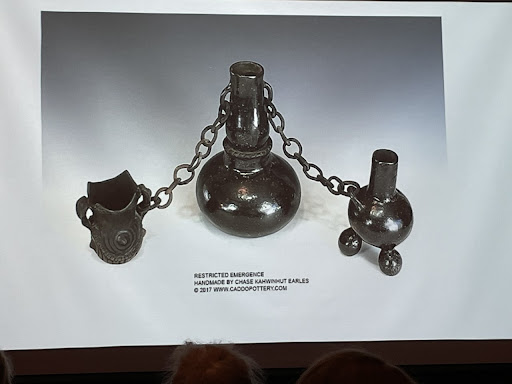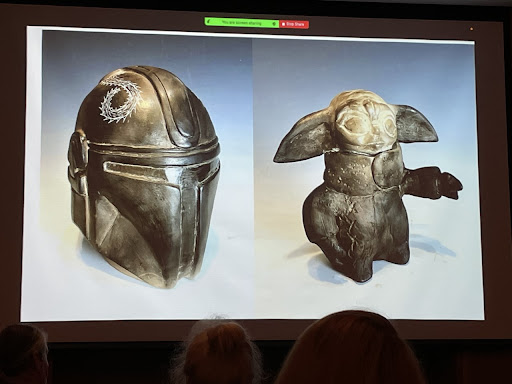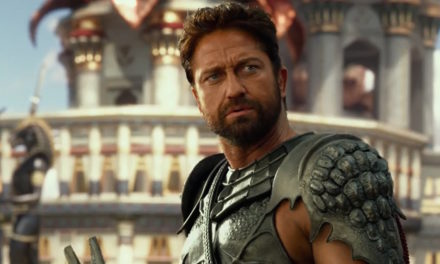While today we may see pottery in TikTok thirst traps or more locally at All Fired Up in Emory Village, there are myriad ceramic pottery traditions stretching back to ancient times that are complex, beautiful and incredibly significant for both history and the present. If one person is the exemplar of that, he is Chase Kahwinhut Earles, a Caddo artist who is dedicated to reviving and honoring the historical creation of Caddo pottery and shaping a future for Indigenous identities in modern day.
Earles presented a lecture titled “Caddo Ceramic Traditions and Trajectories” at the Carlos Museum Sept. 15. This event was developed in collaboration with the Atlanta BeltLine’s Art on the BeltLine project, which aims to make art accessible to all, displaying and celebrating the work of Southeastern artists along the 22-mile gallery that is the BeltLine.
Earles’ own artwork, a 10-foot iron bear effigy, will be displayed on the Atlanta BeltLine Oct. 29 in celebration of the traditional effigy works of Caddo artists. In doing so, Earles hopes to raise awareness of the Southeastern tribes that have made art in this region for centuries, particularly highlighting the culture and artistry of the Caddo people.
Earles’ work as an ambassador of his cultural identity is valuable and necessary, especially as Caddo pottery was almost lost to time when a matriarch of the tribe and the last Caddo potter stopped making Caddo pottery in 1908. Knowledge of this rich artistic history began to disappear as the Caddo tribe was undermined and impeded by colonial powers and conquistador diseases. Earles has used some of his pottery to make a critical commentary on the restriction of said cultural Indigenous knowledge.

Slide during Earles’ lecture featuring his “Restricted Emergence” ceramic artwork.
In order to understand and celebrate Caddo Indigenous knowledge, Earles’ lecture focused on the history of this pottery, the Caddo people as a whole and his own evolution as an artist.
Understanding the role and processes of pottery in the Caddo tribe is and was a large part of Earles’ own constructing process, as he had to learn these ways before he could faithfully produce pottery himself. While he was trained in drawing and painting at Savannah College of Art and Design, he worked with archeologists and Caddo tribe members to rediscover the detailed art of Caddo pottery. Earles digs and dries out his own clay, hand builds the pots without a wheel and then fires them in open wood fires. As somebody who tried to hand mold clay pottery in my technical art history course, I can attest that this process is insanely difficult.
Pottery has been used by the Caddo people both for practical purposes, such as water bottles or food storage containers, as well as spiritual and religious purposes, like the bear effigy referenced above. Children were taught to make basic pottery since they could walk, even making little toys and animals out of clay. Caddo pottery was prized and traded from A.D. 800 to the 1700s, but many people did not get to see such pottery after that time because it was customarily buried with the people who made it when they passed.
The critical role of Caddo pottery as a burial offering means that much of the ancient Caddo pottery found in museums today was taken from Indigenous gravesites, a history of acquisition that is incredibly harmful and damaging. Earles addressed this in his lecture, particularly in terms of display, as he expressed that these culturally sensitive ancient artworks should not be displayed openly, and, if put on display, must be curated in such a way to allow visitors the choice to not look at the work.

Slide during Earles’ lecture depicting his Indigenous Futurism series.
Because of this complexity with the display of ancient Caddo ceramics, Earles sees the recreation of ancient ceramics as a way to educate the public on the tribe’s identity and skill. In order to increase that accessibility even further, he created ceramics in the Caddo style that depict characters and objects from pop culture, from Darth Vader to BB-8. These ceramics are a part of his Indigenous Futurism series, as Earles uses the tradition of effigy-making to take images from “Star Wars,” a series that itself has previously appropriated Indigenous culture, and turns them into cultural and social messages.
As an art history major, I am a firm believer in art’s power to convey meaning, communicate cultural identity, educate the public and serve as an outlet for the artist. In his lecture, Earles discussed feeling as though he had no artistic voice, but when he returned to pottery-making traditions of his own culture, he connected to that personal voice. Earles is dedicated to revitalizing Caddo pottery traditions, using art as a doorway to contemporary understanding and appreciation of Caddo culture.
You can find Earles’ upcoming work on the Atlanta BeltLine or Carlos Museum, as well as at the Dallas Museum of Art, the Gilcrease Museum and the Spiro Mounds Archaeological Center. The world of Caddo pottery that Earles opens up for the viewer awaits you!
Zimra Chickering (24C) is a born and raised Chicagoan who studies art history and nutrition science. She is also a student docent for the Michael C. Carlos Museum, Woodruff JEDI Fellow, educational committee chair for Slow Food Emory, and Xocolatl: Small Batch Chocolate employee. Zimra loves cooking, visiting art museums, photography, doing Muay Thai, drinking coffee, and grocery shopping. She uses writing as an outlet to reflect upon issues and oppurtunities within artistic institutions, and the unique ways in which food and art can act as communicators of culture.





